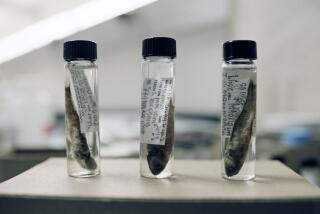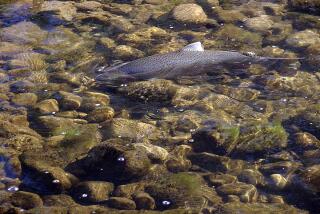Humans Pose Latest Threat to Fish That Has Survived 380 Million Years
The coelacanth, a rare fish that has survived deep in the Earthâs seas almost unchanged for 380 million years, is being threatened by the toxins, greed, curiosity and superstition of one of the planetâs newest residents--humans.
A team of scientists at the Virginia Institute of Marine Science in Gloucester, Va., has found high levels of DDT and PCBs in the tissues of frozen coelacanth (pronounced SEAL-a-kanth) specimens taken from deep water off the southeast coast of Africa.
John A. Musick, who headed the study at the institute, said the fish are being also hunted by impoverished fishermen hoping to meet a growing demand from scientists and taxidermists and by Asians who believe that the fishâs spinal fluid can prolong human life.
By some estimates, at the current rate at which the coelacanths are being killed--perhaps six to 12 a year--they will be extinct in 30 years, he said.
âItâs a very scary situation,â Musick said. âItâs even more alarming because if we lose the coelacanths, weâre not losing a species, or a genus or a family. Weâre losing a superorder--the last member of a species that dominated the worldâs ecology for millions of years.â
Until 1938, when a specimen came up in a trawlerâs net near the Comoro Islands in the Indian Ocean, coelacanths were thought to have been extinct for 70 million years.
Scientists ever since have asked endless questions about these primitively built, five-foot-long fish, not the least of which is its place in the long chain of evolution leading from fish to âtetrapodsâ-- four-legged, air-breathing land animals and man.
But the fish are scarce and, until recently, well-preserved specimens for study have been even more elusive.
In November, 1987, the institute obtained two frozen coelacanths for detailed dissection and study, work that began with a marathon dissection session two months later and has continued with the soon-to-be published toxicological studies.
Institute chemist Robert C. Hale said the levels of PCBs, a highly toxic industrial pollutant, and the pesticide DDT found in the two coelacanths--approaching one part per million--probably did not pose an immediate threat to the coelacanths or to the food chain.
âBut if it increased two or three times, it would be a major concern,â he said. Recent research in California on other fish species suggests that âreproduction is very strongly affected by the body burden of PCBs and DDT. . . . When you start getting into the parts-per-million range, there is a definite effect on spawning success.â
And because they reproduce very slowly, he said, coelacanths would be âparticularly at risk.â
The real surprise for Hale was that a fish from such a remote site and such deep water (they live 650 to 2,000 feet below the surface) had any PCBs at all.
But Musick was not surprised.
âBecause of the global dynamics of the transport (of such substances), there ainât no place you can go. Itâs a sad truth,â he said.
The long-lasting PCBs get into the atmosphere and fall with the rain into the oceans, where they are taken up in the chitin shells of tiny zooplankton.
âAnd virtually everything else munches on these things,â Musick said. Then, because the chitin is indigestible, it falls in fecal pellets to the ocean bottom. There, the PCBs are taken up on the food web of bottom feeders, like the coelacanths.
The presence in the coelacanths of DDT, rather than one of the byproducts of its slow decomposition, was more surprising to Musick.
âThe fact that the animals had DDT indicated the stuff is still being used over . . . in East Africa. And that should be some cause for alarm for people interested in the global environment,â he said. DDT use has been banned in the United States since 1972.
The âfossil fishâ are under a more direct threat from native and foreign collectors. Fishermen can sell a coelacanth carcass to the government of the impoverished Comoros for the equivalent of one or two yearsâ wages, Musick said.
They bring several thousand dollars on the black market, which includes taxidermists and Asians seeking the fishâs spinal fluid, which is regarded as a longevity potion.
Such pressure could mean the end of coelacanths, which scientists believe grow slowly, take a long time to reach sexual maturity and have a small number of young.
âSuch animals tend to be very vulnerable to overfishing and slow in recovering because their reproductive potential is so low,â Musick said.
More to Read
Sign up for Essential California
The most important California stories and recommendations in your inbox every morning.
You may occasionally receive promotional content from the Los Angeles Times.









